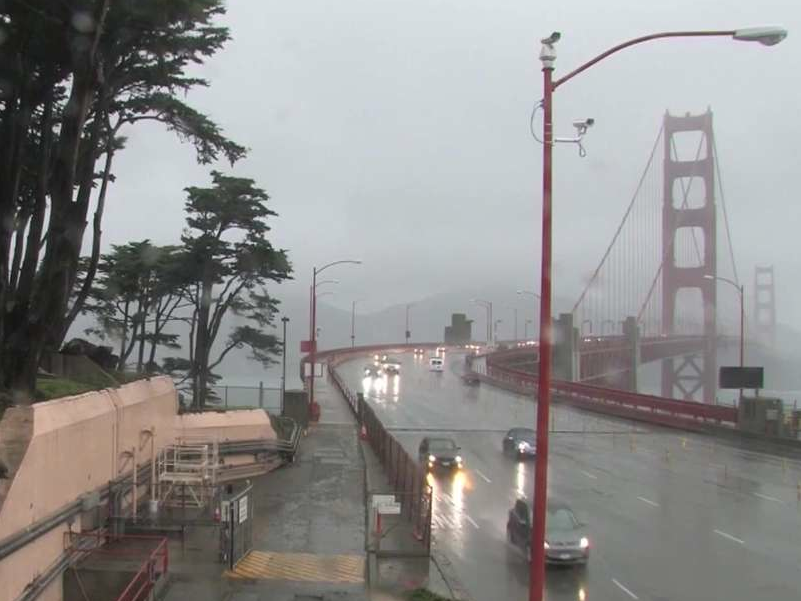The ferocious rainstorm that drenched much of California this week and the smaller storm that hit last week have finally begun moving the needle in the right direction for the drought-ravaged state.
While no one storm could end the state’s historic three-year drought, the rain has finally saturated the grounds in Northern California enough so that the excess water can flow into California’s main water reservoirs.
“It’s the middle of December, and we’ve had two good storm systems,” UC Davis Center for Watershed Studies Director Jay Lund told the San Jose Mercury News. “This could be the end of the drought; we won’t know until late March. But it is certainly an easing of the drought.”
According to the Mercury News, the California Department of Water Resources (DWR) estimates that the state’s largest reservoir, Lake Shasta, will collect 370,000 acre-feet of runoff water by Tuesday. Lake Oroville, the state’s second largest reservoir, is projected to take in 140,000 acre-feet of runoff.
All told, that would come out to 166 billion gallons of water, all from a single storm. Somewhat unsurprisingly, that water will not come close to filling up the state’s reservoirs.
One DWR estimate claims that California will need to see an additional six storm systems like those of the last two weeks between now and April in order to proclaim the drought over and the reservoirs refilled. For example, Lake Shasta was reportedly at 26 percent capacity before the storm; by Tuesday, it is projected to be 34 percent full. Lake Oroville, which sat at 29 percent capacity before the storm, will be just 33 percent full with this storm’s runoff.
“We’re off to a great start,” DWR hydrology chief Sudhakar Talanki told the Mercury News. “But we have a long way to go.”
“The storms so far have been very good,” Santa Clara Valley Water District rep Garth Hall added to the paper. “There has been some localized damage. They are a little intense. But having the quantity of rain from a water-supply point of view is very helpful.”
From another point of view, this storm has been dangerous; according to the Los Angeles Times, firefighters rushed to pull a man out of the Los Angeles River Friday, while they worked to extricate his screaming wife from the surging water.
Bystanders reportedly called the Los Angeles Fire Department when they spotted two individuals clinging to trees in the fast-moving L.A. River. The man was rescued without injury, although he was reportedly hypothermic, while fire crews sent a rescue boat after his wife, who was alert and awake.
Sixty homes in Orange County were being asked to evacuate Friday morning because of their proximity to a mountain heavily scarred by a September fire. Burn-scarred mountains increase the risk of potentially disastrous mudslides and debris flows, O.C. Emergency Operations rep Shannon Widor told the Times.
On the Pacific Coast highway near Malibu, five cars became stuck in 2 feet of mud, and passengers had to be rescued by local firemen, according to the paper.
Meanwhile, 26,000 Los Angeles County residents were waiting Friday morning for Southern California Edison to restore their power. An additional 11,800 customers between San Pedro and Granada Hills were without power, as well as 6,400 PG&E customers in San Luis Obispo County, 4,100 in Kern County, and 2,800 in Santa Barbara County.
John Calka and wife Connie, of Camarillo Springs, told the Times that authorities woke them up in their homes in the middle of the night when rocks began rolling down their street.
“The rocks were two feet in diameter… moving in the middle of the street,” Calka told the paper. “We just kind of watched.”
Further north, desperate residents of the RC Mobile Home park in Redwood City rushed to find higher ground. Redwood City firemen used an inflatable boat to help evacuate stranded residents, according to the San Francisco Chronicle.
“I’ve been taking things off the floor and putting them up high,” Mark Butler told the paper. “The TV, stereo. It’s bad enough being in a trailer park. Now I have to deal with this. It looks like the Bay in here.”
Patricia Albico used a shopping cart to push her belongings through two feet of water while she evacuated her home with her 18-month old son in tow.
“We grabbed blankets, diapers, clothes, anything we could,” Albico told the Chronicle. “I’m nervous. I put the other stuff up high. I hope the water doesn’t go up any more.”

COMMENTS
Please let us know if you're having issues with commenting.